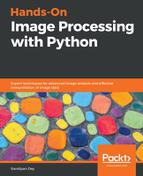Using the Viola—Jones face detection algorithm, faces can be detected in an image using these Haar-like features. Each Haar-like feature is only a weak classifier, and hence a large number of Haar-like features are required to detect a face with good accuracy. A huge number of Haar-like features are computed for all possible sizes and locations of each Haar-like kernel using the integral images. Then an AdaBoost ensemble classifier is used to select important features from the huge number of features and combine them into a strong classifier model during the training phase. The model learned is then used to classify a face region with the selected features.
Most of the regions in an image is a non-face region in general. So, first it is checked whether a window is not a face region. If it is not, it is discarded in a single shot and a different region is inspected where a face is likely to be found. This ensures that more time is dedicated to checking a possible face region. In order to implement this idea, the concept of cascade of classifiers is introduced. Instead of applying all the huge number of features on a window, the features are grouped into different stages of classifiers and applied one-by-one. (The first few stages contain very few features). If a window fails at the first stage it is discarded, and the remaining features on it are not considered. If it passes, the second stage of features are applied, and so on and so forth. A face region corresponds to the window that passes all the stages. These concepts will be discussed more in Chapter 9, Classical Machine Learning Methods in Image Processing.
